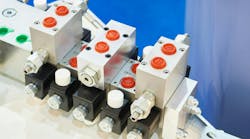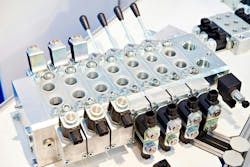*Editor's Note: This article was updated in April 2024.
In nearly every industrial training program that I conduct, someone asks me to explain the differences between servo and proportional valves. I love to hear the question because it presents an opportunity to have some fun. The short answer to the question is, “I refuse to get sucked into the debate.” Technical Standard ISO 10770-1, and the way it deals with the question, only adds to the fun. Before explaining why, I need to provide a little background.
How Fluid Power Technical Standards Define Servo and Proportional Valves
The increasing use of electronics to control all types of hydraulic systems has naturally led to greater interest in servo and proportional valves. This fact has not escaped the eyes of the ISO technical committees that are responsible for developing our international standards, primarily ISO/TC-131/SC-8, the technical committee for standardized testing of hydraulic components.
Technical Committee 131 is the ISO designation for the body that is responsible for all fluid power standards. The official U.S. representative body at the ISO level is the American National Standards Institute, but ANSI has the authority to delegate secretariat functions for any technology to other U.S. national bodies. In the case of fluid power, ANSI has delegated that authority to the National Fluid Power Association (NFPA) located in Milwaukee, WI.
Official Standards and Definitions for Servo and Proportional Valve Technology
The ISO Working Group that developed 10770-1 dodged the bullet in admirable fashion. This was because the convener knew the dispute could never be settled. And yet, the committee wanted a document that covered both servo and proportional valves. But how can you do it without defining them? More specifically, ISO wanted emphasis on the generally accepted use of the terms that proportional valves are used in situations with a lesser pressure drop than were servo valves. (I take vehement exception to this thinking.) Therefore, according to ISO, proportional valves need a lower pressure rating.
The ISO committee decided that servo valves (as has always been the case) would be flow rated at a “rounded off” 1,000 psi, or 7 MPa (1,015 psi), but proportional valves would have a new flow rating pressure of 1 MPa, or about 145 psi.
Part of the document reads, “Set the valve total pressure drop to 1 MPa or 7 MPa, as appropriate.” The “as appropriate” phrase got the committee off the hook. Who judges what is appropriate? Well, the testers do. They can test it at either servo or proportional levels. But, more importantly, they can call the valve anything they want! So now we have proportional valves that are flow rated and tested at 1000 psi. We also have “zero-lapped proportional valves,” so this war of words may never be won, only fought.
READ MORE: Understanding Electrohydraulic Valve Types
The Reality of the Situation
Only one question influences whether a servo valve should be selected over a proportional valve, or vice versa: Does the performance of the valve meet the requirements demanded of the application? Answering that question, unfortunately, usually requires more than just some definitions. It requires translating the application needs into the valve performance specifications or vice-versa.
This usually involves some calculations, which are not normally taught in basic hydraulics courses. Nonetheless, the methods are straightforward, if not tedious, but will lead to good, reliable, high performance system designs. More importantly, though, the calculations can be performed so that such questions as “How much overlap can I tolerate?” are answered quantitatively, without ambiguity.


